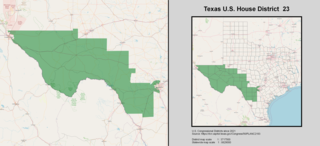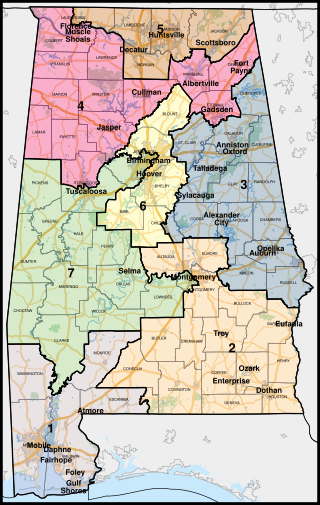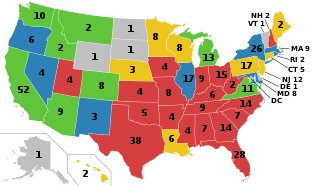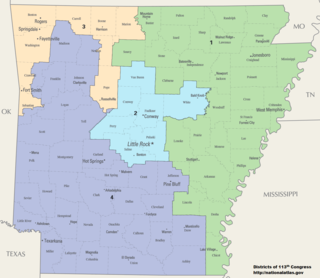Related Research Articles
Wesberry v. Sanders, 376 U.S. 1 (1964), was a landmark U.S. Supreme Court case in which the Court ruled that districts in the United States House of Representatives must be approximately equal in population. Along with Baker v. Carr (1962) and Reynolds v. Sims (1964), it was part of a series of Warren Court cases that applied the principle of "one person, one vote" to U.S. legislative bodies.
Baker v. Carr, 369 U.S. 186 (1962), was a landmark United States Supreme Court case in which the Court held that redistricting qualifies as a justiciable question under the equal protection clause of the Fourteenth Amendment, thus enabling federal courts to hear Fourteenth Amendment-based redistricting cases. The court summarized its Baker holding in a later decision as follows: "the Equal Protection Clause of the Fourteenth Amendment limits the authority of a State Legislature in designing the geographical districts from which representatives are chosen either for the State Legislature or for the Federal House of Representatives.". The court had previously held in Gomillion v. Lightfoot that districting claims over racial discrimination could be brought under the Fifteenth Amendment.

The Virginia General Assembly is the legislative body of the Commonwealth of Virginia, the oldest continuous law-making body in the Western Hemisphere, the first elected legislative assembly in the New World, and was established on July 30, 1619. The General Assembly is a bicameral body consisting of a lower house, the Virginia House of Delegates, with 100 members, and an upper house, the Senate of Virginia, with 40 members. Senators serve terms of four years, and Delegates serve two-year terms. Combined, the General Assembly consists of 140 elected representatives from an equal number of constituent districts across the commonwealth. The House of Delegates is presided over by the Speaker of the House, while the Senate is presided over by the Lieutenant Governor of Virginia. The House and Senate each elect a clerk and sergeant-at-arms. The Senate of Virginia's clerk is known as the "Clerk of the Senate".
Redistricting in the United States is the process of drawing electoral district boundaries. For the United States House of Representatives, and state legislatures, redistricting occurs after each decennial census.
Reynolds v. Sims, 377 U.S. 533 (1964), was a landmark United States Supreme Court case in which the Court ruled that the electoral districts of state legislative chambers must be roughly equal in population. Along with Baker v. Carr (1962) and Wesberry v. Sanders (1964), it was part of a series of Warren Court cases that applied the principle of "one person, one vote" to U.S. legislative bodies.
Miller v. Johnson, 515 U.S. 900 (1995), was a United States Supreme Court case concerning "affirmative gerrymandering/racial gerrymandering", where racial minority-majority electoral districts are created during redistricting to increase minority Congressional representation.

The 2003 Texas redistricting was a controversial intercensus state plan that defined new congressional districts. In the 2004 elections, this redistricting supported the Republicans taking a majority of Texas's federal House seats for the first time since Reconstruction. Democrats in both houses of the Texas Legislature staged walkouts, unsuccessfully trying to prevent the changes. Opponents challenged the plan in three suits, combined when the case went to the United States Supreme Court in League of United Latin American Citizens v. Perry (2006).

Texas's 23rd congressional district stretches across the southwestern portion of Texas. It is a majority Hispanic district and has been represented by Republican Tony Gonzales since 2021.
Congressional districts, also known as electoral districts in other nations, are divisions of a larger administrative region that represent the population of a region in the larger congressional body. Countries with congressional districts include the United States, the Philippines, and Japan.

The U.S. state of Alabama is currently divided into seven congressional districts, each represented by a member of the United States House of Representatives.
Michigan's 14th congressional district was a congressional district that stretched from eastern Detroit westward to Farmington Hills, then north to the suburb of Pontiac. From 1993 to 2013, it was based entirely in Wayne County.
Texas has had at-large congressional seats at various times in its history. It was often the case when the state received new congressional seats as a result of reapportionment, that it would have a representative elected from an at-large seat, voted on by all voters in the state. This enabled the legislature, which was dominated by legislators from rural districts, to postpone re-districting that would reduce their power by apportioning districts to recognize the increased population and economic power of the developing major cities.

Gerrymandering is the practice of setting boundaries of electoral districts to favor specific political interests within legislative bodies, often resulting in districts with convoluted, winding boundaries rather than compact areas. The term "gerrymandering" was coined after a review of Massachusetts's redistricting maps of 1812 set by Governor Elbridge Gerry noted that one of the districts looked like a mythical salamander.

The 2020 United States redistricting cycle is in progress following the completion of the 2020 United States census. In all fifty states, various bodies are re-drawing state legislative districts. States that are apportioned more than one seat in the United States House of Representatives are also drawing new districts for that legislative body.

Redistricting in Wisconsin is the process by which boundaries are redrawn for municipal wards, Wisconsin State Assembly districts, Wisconsin State Senate districts, and Wisconsin's congressional districts. Redistricting typically occurs—as in other U.S. states—once every decade, usually in the year after the decennial United States census. According to the Wisconsin Constitution, redistricting in Wisconsin follows the regular legislative process, it must be passed by both houses of the Wisconsin Legislature and signed by the Governor of Wisconsin—unless the Legislature has sufficient votes to override a gubernatorial veto. Due to political gridlock, however, it has become common for Wisconsin redistricting to be conducted by courts. The 1982, 1992, and 2002 legislative maps were each created by panels of United States federal judges.

The U.S. state of Arkansas, in common with the other U.S. states, must redraw its congressional and legislative districts every ten years to reflect changes in the state and national populations. Redistricting follows the completion of the United States census, which is carried out by the federal government in years that end in 0; the most recent census took place in 2020.
The 2010 United States redistricting cycle took place following the completion of the 2010 United States census. In all fifty states, various bodies re-drew state legislative districts. States that are apportioned more than one seat in the United States House of Representatives also drew new districts for that legislative body. The resulting new districts were first implemented for the 2011 and 2012 elections.
The 2000 United States redistricting cycle took place following the completion of the 2000 United States census. In all fifty states, various bodies re-drew state legislative and congressional districts. States that are apportioned more than one seat in the United States House of Representatives also drew new districts for that legislative body. The resulting new districts were first implemented for the 2001 and 2002 elections, which saw Republicans add eight seats to their U.S. House majority, capture eight state legislative chambers and win a majority of state legislative seats for the first time in half a century.
The 1990 United States redistricting cycle took place following the completion of the 1990 United States census. In all fifty states, various bodies re-drew state legislative and congressional districts. States that are apportioned more than one seat in the United States House of Representatives also drew new districts for that legislative body. The resulting new districts were first implemented for the 1991 and 1992 elections, which saw Democrats lose nine seats from their U.S. House majority and lose sixteen state legislative chambers but continue to retain a majority of state legislative seats nationwide throughout the decade. To date, it is the last time that Democrats held a majority of state legislative seats throughout an entire census cycle.
The 1980 United States redistricting cycle took place following the completion of the 1980 United States census. In all fifty states, various bodies re-drew state legislative and congressional districts. States that are apportioned more than one seat in the United States House of Representatives also drew new districts for that legislative body. The resulting new districts were first implemented for the 1981 and 1982 elections.
References
- ↑ "Redistricting Systems: A 50-State Overview". www.ncsl.org. Retrieved June 29, 2022.